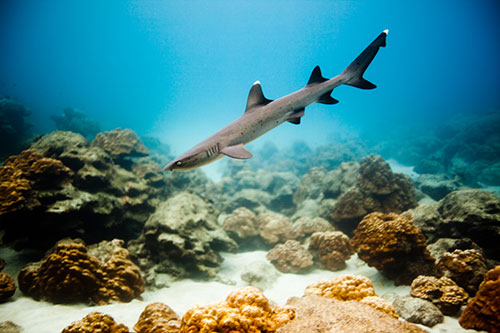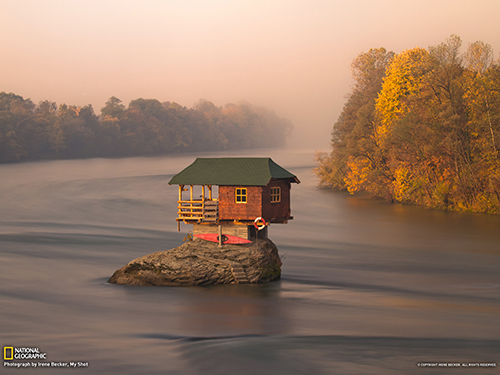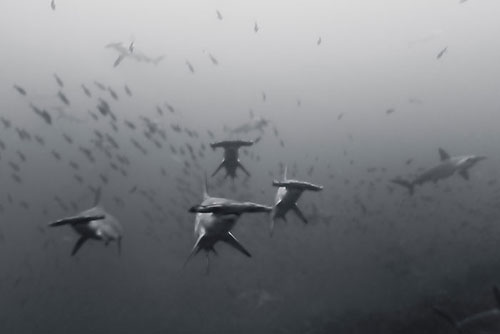|
By John Pint
 This was a talk I did not want to miss. National Geographic
photographer Ben Horton was to speak about his work as an explorer
during a conference promoting a new series of textbooks for teaching
English with NatGeo photos and themes. Since I'm interested in both
exploration and teaching, this looked exactly like my cup of tea, and
so it was. I just regret that so few people turned out for what I'd say
was one of the best adventure and conservation presentations I've ever
experienced.
This was a talk I did not want to miss. National Geographic
photographer Ben Horton was to speak about his work as an explorer
during a conference promoting a new series of textbooks for teaching
English with NatGeo photos and themes. Since I'm interested in both
exploration and teaching, this looked exactly like my cup of tea, and
so it was. I just regret that so few people turned out for what I'd say
was one of the best adventure and conservation presentations I've ever
experienced.
This event took place December 2, 2014 at the Intercontinental
Hotel in Guadalajara, Mexico.
It was organized by a textbook-multimedia Publisher called National
Geographic Learning, part of Cengage Learning. Jair Felix of Cengage
started off by introducing us to Our World, a colorful six-level course
for young learners of English. You open the books to any unit and the
first thing you see is one of those “Wow!” pictures from National
Geographic, the kind that makes both kids and adults ask: Is this for
real? Does this place or creature actually exist?
 For example, in a unit for beginners, a page innocently titled “My
House” shows an amazing photograph of a cozy little house perched high
upon a decidedly too small rock smack in the middle of a river in
Serbia. The kids learn the usual vocabulary related to houses, like
roof, window and yard, but through images that raise their eyebrows and
rivet their attention. At a higher level, this sort of picture may
accompany a reading on how King Tut died or a discussion of
Anthropology by a NatGeo “explorer-in-residence” explaining what it was
that attracted him to this profession. What an improvement over the
boring textbooks that used to discourage kids from learning a foreign
language!
For example, in a unit for beginners, a page innocently titled “My
House” shows an amazing photograph of a cozy little house perched high
upon a decidedly too small rock smack in the middle of a river in
Serbia. The kids learn the usual vocabulary related to houses, like
roof, window and yard, but through images that raise their eyebrows and
rivet their attention. At a higher level, this sort of picture may
accompany a reading on how King Tut died or a discussion of
Anthropology by a NatGeo “explorer-in-residence” explaining what it was
that attracted him to this profession. What an improvement over the
boring textbooks that used to discourage kids from learning a foreign
language!
My wife Susy, who teaches Spanish, commented on Our World: “I liked
their concept of children learning English by visiting other countries
through the photos and the themes. This might awaken in them a desire
to travel, to know the world. What a great idea for children to
discover the world while sitting in the classroom!”
The second speaker was Ben Horton, who, we were told by way of
introduction, had once been “National Geographic's youngest
explorer” and recipient of a US $5000 grant to carry out a study of his
own choosing in Costa Rica. Horton, born in Bermuda, was a very
laid-back speaker who matter-of-factly related one mind-blowing story
after another, accompanied by just the sort of spectacular photos you'd
expect from a NatGeo photographer.
Deeply disturbed because the world's shark population had dropped 93%
since 1950, Horton went off to Cocos Island, located 480 kilometers off
Costa Rica, where, even though the waters are supposedly protected,
“illegal poaching of sharks and other endangered species is a daily
occurrence.”
 Horton continued: “For every single poacher we caught in our patrols of
the Island, at least 20 went unnoticed and unimpeded. Sometimes the
boats were too big for us to run down in our little patrol boats, and
other times the culprit happened to be the father in law of the captain
of our patrol boat. When the boats saw us coming, they would ditch
their long lines which were miles long, with hooks placed every 50 feet
or so, and we would return to pull the lines out by hand, freeing
whatever was hooked. Every day, we would pull between 16 and 20 miles
of line out of the water, more than enough to completely wrap around
the island.”
Horton continued: “For every single poacher we caught in our patrols of
the Island, at least 20 went unnoticed and unimpeded. Sometimes the
boats were too big for us to run down in our little patrol boats, and
other times the culprit happened to be the father in law of the captain
of our patrol boat. When the boats saw us coming, they would ditch
their long lines which were miles long, with hooks placed every 50 feet
or so, and we would return to pull the lines out by hand, freeing
whatever was hooked. Every day, we would pull between 16 and 20 miles
of line out of the water, more than enough to completely wrap around
the island.”
The number one endangered species the poachers were after was the
shark. Horton discovered that fishermen were willing to travel to Cocos
Island from all over the world simply because shark fins sell for US
$800 a kilo, “and the more rare the shark, the higher the price.”
To understand the whole story, Horton took his camera to Hong Kong
where thousands of shark fins are sold to Chinese people to make soup.
“Believe it or not,” he told us, “shark fins have no flavor and no
nutritional value whatsoever.” It seems the Chinese want to eat shark
because sharks are strong, and they believe “What you eat is what you
are.”
Ben Horton says 120 million sharks are being killed for their fins
every year. The fins are cut off and the shark carcass is thrown back
into the water. Horton's excellent photo documentation of the process
from Coco Island to Hong Kong markets came to the attention of people
like Jackie Chan and Richard Branson who are now strong advocates for
ending the senseless slaughter of these creatures.
Horton's work
has brought him some unforgettable encounters with wild creatures. “My
favorite experiences,” he says, “are when I have spent long enough in a
place that I start to really connect with my subject. One that stands
out to me is this: After a month in the Arctic, I was sitting writing
in my journal and seven wolves approached me. When I sat still, they
came right up to me and started sniffing me up and down. It was easy to
see they weren't being aggressive, but it was still a thrilling
experience.”
Another story Horton told us was about his mother's
visit to Cocos Island. Worried about crocodiles in the water, he
encouraged her to look for birds along a certain trail. “My mother is
an avid birdwatcher,” he told us, “with an amazing ability to walk
extremely slowly and silently down a path.” He says his mother was so
good at this that she may be the first person in history to have seen a
puma before the puma saw her. When this occurred, Ben's mother gave a
yelp, which scared the puma, and they both ran off in opposite
directions.
Horton has also had some unnerving close encounters
both with sharks and crocodiles, but you'll have to go to one of his
presentations to get the stories straight from his lips. If you have
the chance, donīt miss it. Meanwhile, you can peruse his fine photos at
benhorton.biz and read his blog.
And
now, let me leave you with a final thought from Ben Horton on why he
does what he does: “Getting people to fall in love with our world is
the first step to getting them to protect it. Photography is how I can
help that happen.”

|

